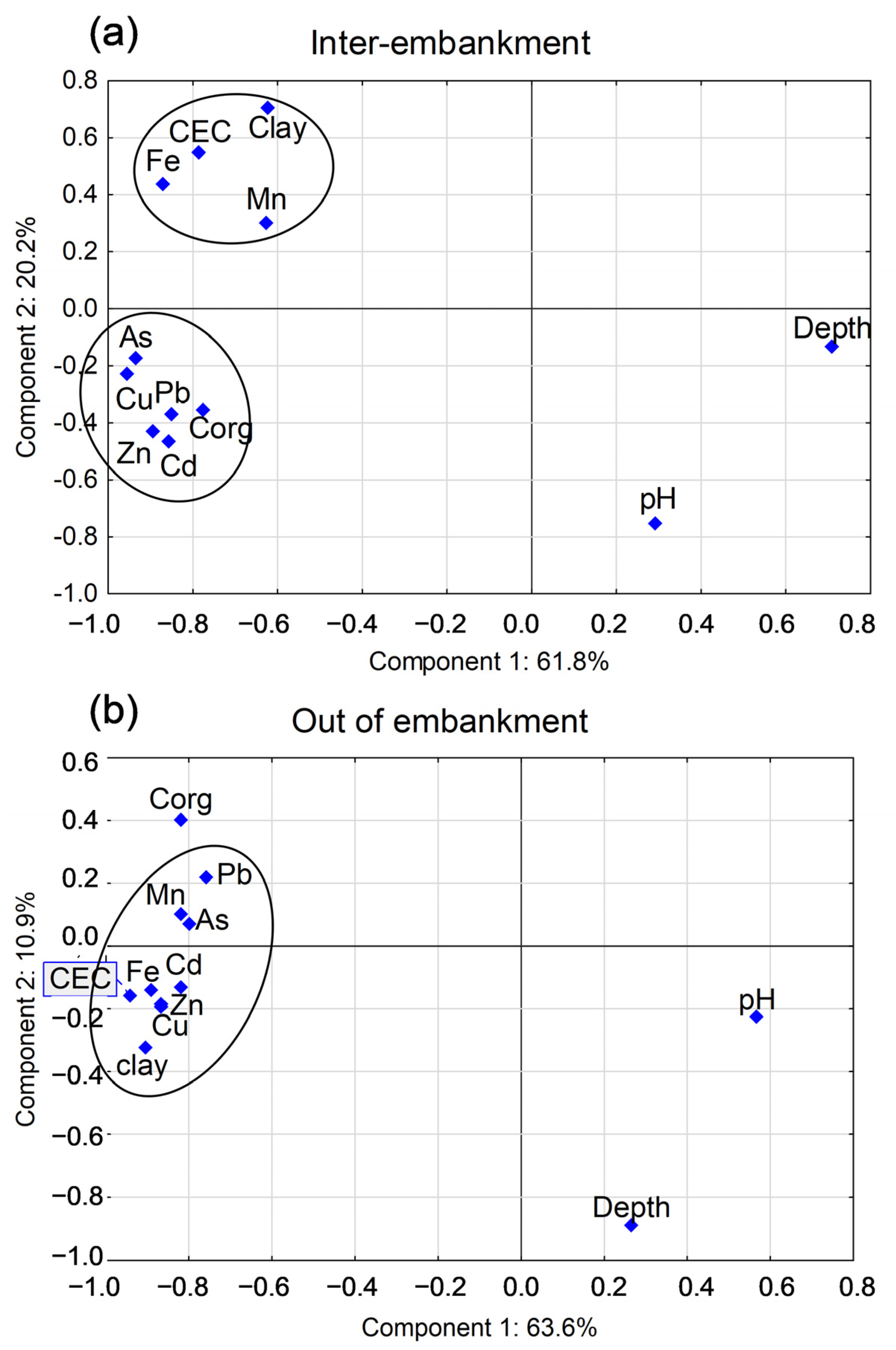Profile Distributions of Potentially Toxic Metal(loid)s in Soils of the Middle Odra Floodplain (SW Poland)
Abstract
:1. Introduction
2. Materials and Methods
2.1. Research Area and Location of Soil Profiles
2.2. Soil Sampling and Analysis
2.3. Data Analysis
3. Results and Discussion
3.1. Basic Soil Properties
3.2. Metal(loid)s in Soil Profiles
3.3. Factors That Determine Soil Concentrations of Metal(loid)s
3.4. Assessment of Local Geochemical Background
3.5. Assessment of Soil Contamination and Environmental Risk
4. Conclusions
Supplementary Materials
Author Contributions
Funding
Institutional Review Board Statement
Informed Consent Statement
Data Availability Statement
Acknowledgments
Conflicts of Interest
References
- Rinklebe, J.; Shaheen, S.M. Assessing the mobilization of cadmium, lead, and nickel using a seven-step sequential extraction technique in contaminated floodplain soil profiles along the central Elbe River, Germany. Water Air Soil Poll. 2014, 225, 2039. [Google Scholar] [CrossRef]
- Dung, T.T.; Cappuyns, V.; Swennen, R.; Phung, N.K. From geochemical background determination to pollution assessment of heavy metals in sediments and soils. Rev. Environ. Sci. Bio./Technol. 2013, 12, 335–353. [Google Scholar] [CrossRef]
- Frohne, T.; Rinklebe, J.; Diaz-Bone, R.A. Contamination of foodplain soils along the Wupper river, Germany, with As Co, Cu, Ni, Sb, and Zn and the impact of predefnite redox variations on the mobility of these elements. Soil Sediment Contam. Int. J. 2014, 23, 779–799. [Google Scholar] [CrossRef]
- Popov, S.I.; Stafilov, T.; Šajn, R.; Tănăselia, C. Distribution of trace elements in sediment and soil from river Vardar basin, Macedonia/Greece. J. Environ. Sci. Health Part A 2016, 51, 1–14. [Google Scholar] [CrossRef]
- Suleymanov, R.; Dorogaya, E.; Gareev, A.; Minnegaliev, A.; Gaynanshin, M.; Zaikin, S.; Belan, L.; Tuktarova, I.; Suleymanov, A. Assessment of Chemical Properties, Heavy Metals, and Metalloid Contamination in Floodplain Soils under the Influence of Copper Mining: A Case Study of Sibay, Southern Urals. Ecologies 2022, 3, 530–538. [Google Scholar] [CrossRef]
- Kanianska, R.; Varga, J.; Benková, N.; Kizeková, M.; Jančová, Ľ. Floodplain soils contamination assessment using the sequential extraction method of heavy metals from past mining activities. Sci. Rep. 2022, 12, 2927. [Google Scholar] [CrossRef] [PubMed]
- Cebula, E.; Ciba, J. Effects of flooding in southern Poland on heavy metal concentrations in soils. Soil Use Manag. 2005, 21, 348–351. [Google Scholar] [CrossRef]
- Barać, N.; Škrivanj, S.; Bukumirić, Z.; Živojinović, D.; Manojlović, D.; Barać, M.; Petrović, R.; Ćorac, A. Distribution and mobility of heavy elements in floodplain agricultural soils along the Ibar River (Southern Serbia and Northern Kosovo). Chemometric investigation of pollutant sources and ecological risk assessment. Environ. Sci. Pollut. Res. 2016, 23, 9000–9011. [Google Scholar] [CrossRef]
- Ciszewski, D.; Grygar, T.M. A review of flood-related storage and remobilization of heavy metal pollutants in river systems. Water Air Soil Pollut. 2016, 227, 239. [Google Scholar] [CrossRef] [Green Version]
- Kotková, K.; Nováková, T.; Tůmová, Š.; Kiss, T.; Popelka, J.; Faměra, M. Migration of risk elements within the floodplain of the Litavka River, the Czech Republic. Geomorphology 2019, 329, 46–57. [Google Scholar] [CrossRef]
- Absalon, D.; Matysik, M. Changes in water quality and runoff in the Upper Oder River Basin. Geomorphology 2007, 92, 106–118. [Google Scholar] [CrossRef]
- Aleksander-Kwaterczak, U.; Helios-Rybicka, E. Contaminated sediments as a potential source of Zn, Pb, and Cd for a river system in the historical metalliferous ore mining and smelting industry area of South Poland. J. Soils Sediments 2009, 9, 13–22. [Google Scholar] [CrossRef]
- Ciszewski, D.; Turner, J. Storage of sediment-associated heavy metals along the channelized Odra River, Poland. Earth Surf. Proc. Landforms 2009, 34, 558–572. [Google Scholar] [CrossRef]
- Jabłońska-Czapla, M.; Nocoń, K.; Szopa, S.; Łyko, A. Impact of the Pb and Zn ore mining industry on the pollution of the Biała Przemsza River, Poland. Environ. Monit. Assess. 2016, 188, 262. [Google Scholar] [CrossRef] [PubMed] [Green Version]
- Faměra, M.; Grygar, T.M.; Ciszewski, D.; Czajka, A.; Álvarez-Vázquez, M.Á.; Hron, K.; Fačevicová, K.; Hýlová, V.; Tůmová, Š.; Světlík, I.; et al. Anthropogenic records in a fluvial depositional system: The Odra River along The Czech-Polish border. Anthropocene 2021, 34, 100286. [Google Scholar] [CrossRef]
- Strzebońska, M.; Jarosz-Krzemińska, E.; Adamiec, E. Assessing historical mining and smelting effects on heavy metal pollution of river systems over span of two decades. Water Air Soil Pollut. 2017, 228, 141. [Google Scholar] [CrossRef] [PubMed] [Green Version]
- Czaja, S. Changes in river discharge structure and regime in mining-industrial-urban areas. Reg. Environ. Chang. 2005, 5, 18–26. [Google Scholar] [CrossRef]
- Ciszewski, D.; Czajka, A. Human-induced sedimentation patterns of a channelized lowland river. Earth Surf. Proc. Landforms 2015, 40, 783–795. [Google Scholar] [CrossRef]
- Bojakowska, I.; Sokołowska, G. Influence of ore mining and metallurgy for pollution of the Odra River alluvial deposits with trace elements. Przegl. Geolog. 1998, 46, 603–608. (In Polish) [Google Scholar]
- Ciszewski, D. Heavy metals in vertical profiles of the middle Odra River overbank sediments: Evidence for pollution changes. Water Air Soil Pollut. 2003, 143, 81–98. [Google Scholar] [CrossRef]
- Lis, J.; Pasieczna, A. (Eds.) Geochemical Atlas of Poland; 1:2 500 000; Państwowy Instytut Geologiczny: Warszawa, Poland, 1995; pp. 1–72.
- Karczewska, A.; Kaszubkiewicz, J.; Kabała, C.; Jezierski, P.; Spiak, Z.; Szopka, K. Tailings impoundments of Polish copper mining industry—Environmental effects, risk assessment and reclamation. In Assessment, Restoration and Reclamation of Mining Influenced Soils; Academic Press: Cambridge, MA, USA, 2017; pp. 149–202. [Google Scholar] [CrossRef]
- Tomassi-Morawiec, H.; Lis, J.; Pasieczna, A. Geochemical Atlas of Wrocław and Environs. 1: 100 000. Part 1; Państwowy Instytut Geologiczny: Warszawa, Poland, 1998; pp. 1–76.
- Kaszubkiewicz, J.; Pora, E.; Kawałko, D.; Jezierski, P.; Gałka, B. Comparison of total content of zinc and arsenic in soils of Średzka Upland and Wrocław Ice-Marginal Valley. Environ. Prot. Nat. Res. 2014, 25, 35–40. [Google Scholar] [CrossRef] [Green Version]
- Gielar, A.; Helios-Rybicka, E.; Möller, S.; Einax, J.W. Multivariate analysis of sediment data from the upper and middle Odra River (Poland). Appl. Geochem. 2012, 27, 1540–1545. [Google Scholar] [CrossRef]
- Schulz-Zunkel, C.; Krueger, F. Trace metal dynamics in floodplain soils of the River Elbe: A review. J. Environ. Qual. 2009, 38, 1349–1362. [Google Scholar] [CrossRef] [PubMed]
- Debnath, A.; Singh, P.K.; Sharma, Y.C. Metallic contamination of global river sediments and latest developments for their remediation. J. Environ. Manag. 2021, 298, 113378. [Google Scholar] [CrossRef]
- Ponting, J.; Kelly, T.J.; Verhoef, A.; Watts, M.J.; Sizmur, T. The impact of increased flooding occurrence on the mobility of potentially toxic elements in floodplain soil—A review. Sci. Total Environ. 2021, 754, 142040. [Google Scholar] [CrossRef]
- Lynch, S.F.; Batty, L.C.; Byrne, P. Environmental risk of metal mining contaminated river bank sediment at redox-transitional zones. Minerals 2014, 4, 52–73. [Google Scholar] [CrossRef] [Green Version]
- Gorny, J.; Billon, G.; Lesven, L.; Dumoulin, D.; Madé, B.; Noiriel, C. Arsenic behavior in river sediments under redox gradient: A review. Sci. Total Environ. 2015, 505, 423–434. [Google Scholar] [CrossRef] [PubMed]
- Lewińska, K.; Karczewska, A.; Siepak, M.; Szopka, K.; Gałka, B.; Iqbal, M. Effects of waterlogging on the solubility of antimony and arsenic in variously treated shooting range soils. Appl. Geochem. 2019, 105, 7–16. [Google Scholar] [CrossRef]
- Szopka, K.; Gruss, I.; Gruszka, D.; Karczewska, A.; Gediga, K.; Gałka, B.; Dradrach, A. The effects of forest litter and waterlogging on the ecotoxicity of soils strongly enriched in arsenic in a historical mining site. Forests 2021, 12, 355. [Google Scholar] [CrossRef]
- Alloway, B.J. (Ed.) Heavy metals in soils. In Trace Metals and Metalloids in Soils and Their Bioavailability; Springer: Dordrecht, The Netherlands, 2013. [Google Scholar] [CrossRef]
- Caporale, A.G.; Violante, A. Chemical processes affecting the mobility of heavy metals and metalloids in soil environments. Curr. Poll Rep. 2016, 2, 15–27. [Google Scholar] [CrossRef] [Green Version]
- Marks, L. Quaternary glaciations in Poland. In Developments in Quaternary Sciences; Elsevier: Amsterdam, The Netherlands, 2011; Volume 15, pp. 299–303. [Google Scholar] [CrossRef]
- Kabała, C. (Ed.) Soils of Lower Silesia. Origins, Diversity and Protection; Monograph. Polish Society of Soil Science, Polish Humic Substances Society; PTG; PTSH: Wrocław, Poland, 2015; Available online: https://www.org.up.wroc.pl/igosr/PTG29/monografia.pdf (accessed on 1 September 2022).
- Kawałko, D.; Jezierski, P.; Kabała, C. Morphology and physicochemical properties of alluvial soils in riparian forests after river regulation. Forests 2021, 12, 329. [Google Scholar] [CrossRef]
- Głuchowska, B.; Pływaczyk, L. Contemporary Problems in Environmental Engineering. In Groundwater Level in the Odra River Valley Downstream the Brzeg Dolny; Wydawnictwo UP We: Wrocławiu, Poland, 2008; pp. 1–109. [Google Scholar]
- Kabala, C.; Gałka, B.; Jezierski, P.; Bogacz, A. Transformation of Fluvisols caused by river regulation and long-term farming—A case study from the Dobra River valley in the Silesian Lowland. Rocz. Glebozn. (Soil Sci. Annu.) 2011, 62, 141–153. [Google Scholar]
- FAO-WRB. World Reference Base for Soil Resources 2014, update 2022. In International Soil Classification System for Naming Soils and Creating Legends for Soil Maps, 4th ed.; IUSS Working Group WRB; International Union of Soil Sciences (IUSS): Vienna, Austria, 2022. [Google Scholar]
- Papuga, K.; Kaszubkiewicz, J.; Wilczewski, W.; Stas, M.; Belowski, J.; Kawałko, D. Soil grain size analysis by the dynamometer method—A comparison to the pipette and hydrometer method. Soil Sci. Ann. 2018, 69, 17–27. [Google Scholar] [CrossRef]
- Tan, K. Soil Sampling, Preparation, and Analysis, 2nd ed.; CRC Press: Boca Raton, FL, USA, 2005. [Google Scholar]
- ISO 11466; Soil Quality; Extraction of Trace Elements Soluble in Aqua Regia. International Standarization Organization: Geneva, Switzerland; ISO: London, UK, 1995.
- Reid, M.K.; Spencer, K.L. Use of principal components analysis (PCA) on estuarine sediment datasets: The effect of data pre-treatment. Environ. Pollut. 2009, 157, 2275–2281. [Google Scholar] [CrossRef] [PubMed]
- Šajn, R.; Halamić, J.; Peh, Z.; Galović, L.; Alijagić, J. Assessment of the natural and anthropogenic sources of chemical elements in alluvial soils from the Drava River using multivariate statistical methods. J. Geochem. Explor. 2011, 110, 278–289. [Google Scholar] [CrossRef]
- Li, P.; Qian, H.; Howard, K.W.; Wu, J. Heavy metal contamination of Yellow River alluvial sediments, northwest China. Environ. Earth Sci. 2015, 73, 3403–3415. [Google Scholar] [CrossRef]
- Setia, R.; Dhaliwal, S.S.; Singh, R.; Kumar, V.; Taneja, S.; Kukal, S.S.; Pateriya, B. Phytoavailability and human risk assessment of heavy metals in soils and food crops around Sutlej river, India. Chemosphere 2021, 263, 128321. [Google Scholar] [CrossRef] [PubMed]
- Macklin, M.G.; Benito, G.; Gregory, K.J.; Johnstone, E.; Lewin, J.; Michczyńska, D.J.; Soja, R.; Starkel, L.; Thorndycraft, V.R. Past hydrological events reflected in the Holocene fluvial record of Europe. Catena 2006, 66, 145–154. [Google Scholar] [CrossRef]
- Du Laing, G.; Rinklebe, J.; Vandecasteele, B.; Meers, E.; Tack, F.M.G. Trace metal behaviour in estuarine and riverine floodplain soils and sediments: A review. Sci. Total Environ. 2009, 407, 3972–3985. [Google Scholar] [CrossRef]
- Łabaz, B.; Bogacz, A.; Kabała, C. Anthropogenic transformation of soils in the Barycz valley-conclusions for soil classification. Soil Sci. Ann. 2014, 65, 103. [Google Scholar] [CrossRef] [Green Version]
- Salminen, T. (Ed.) Geochemical Atlas of Europe Part 1: Background Information, Methodology and Maps; EuroGeosurveys & Foregs: Espoo, Finland, 2004; pp. 1–690. [Google Scholar]
- Lado, L.R.; Hengl, T.; Reuter, H.I. Heavy metals in European soils: A geostatistical analysis of the FOREGS Geochemical database. Geoderma 2008, 148, 189–199. [Google Scholar] [CrossRef]
- Regulation of the Minister for the Environment of 1 September 2016 on the Method How to Carry out the Assessment of Soil Contamination. Polish Journal of Laws of 2016, Item 1395; 2016; (In Polish). Available online: https://isap.sejm.gov.pl/isap.nsf/DocDetails.xsp?id=wdu20160001395 (accessed on 20 January 2023).
- Reimann, C.; Fabian, K.; Birke, M.; Filzmoser, P.; Demetriades, A.; Négrel, P.; Oorts, K.; Matschullat, J.; de Caritat, P.; Albanese, S.; et al. GEMAS: Establishing geochemical background and threshold for 53 chemical elements in European agricultural soil. Appl. Geochem. 2018, 88, 302–318. [Google Scholar] [CrossRef] [Green Version]
- Komárek, M.; Vaněk, A.; Ettler, V. Chemical stabilization of metals and arsenic in contaminated soils using oxides—A review. Environ. Pollut. 2013, 172, 9–22. [Google Scholar] [CrossRef]
- Wenzel, W.W. Arsenic. In Heavy Metals in Soils. Trace Metals and Metalloids in Soils and Their Bioavailability, 3rd ed.; Alloway, B.J., Ed.; Springer: Berlin/Heidelberg, Germany, 2013; pp. 241–282. [Google Scholar] [CrossRef]
- Szerszeń, L.; Laskowski, S.; Kollender-Szych, A. Wpływ procesów typologicznych na zawartość arsenu w niektórych gatunkach Mad Odrzańskich z okolic Głogowa. Effect of typological processes on the arsenic content in some kinds of Odra alluvial soils in the environs of Głogów. Zesz. Probl. Post Nauk. Roln. 1983, 242, 83–89. (In Polish) [Google Scholar]
- Reimann, C.; Garrett, R.G. Geochemical background—Concept and reality. Sci. Total Environ. 2005, 350, 12–27. [Google Scholar] [CrossRef] [PubMed]
- Gałuszka, A.; Migaszewski, Z.M. Geochemical background—An environmental perspective. Mineralogia 2011, 42, 7–17. [Google Scholar] [CrossRef]
- Wang, Z.; Darilek, J.L.; Zhao, Y.; Huang, B.; Sun, W. Defining soil geochemical baselines at small scales using geochemical common factors and soil organic matter as normalizers. J. Soils Sediments 2011, 11, 3–14. [Google Scholar] [CrossRef]
- Wang, Z.; Wang, K.; Huang, B.; Darilek, J.L.; Zhao, Y. A novel statistical method of defining geochemical baselines and source identification for trace metals in soil in Zhangjiagang County, China. J. Soils Sediments 2021, 21, 2619–2627. [Google Scholar] [CrossRef]
- Mao, L.; Kong, H.; Li, F.; Chen, Z.; Wang, L.; Lin, T.; Lu, Z. Improved geochemical baseline establishment based on diffuse sources contribution of potential toxic elements in agricultural alluvial soils. Geoderma 2022, 410, 115669. [Google Scholar] [CrossRef]
- Karczewska, A.; Kabała, C. Environmental risk assessment as a new basis for evaluation of soil contamination in Polish law. Soil Sci. Ann. 2017, 68, 67. [Google Scholar] [CrossRef] [Green Version]





| Parameter | All Samples | Inter-Embankment Zone (In) | Out of Embankment (Out) | ||||
|---|---|---|---|---|---|---|---|
| All | Top Layers 1 | >60 cm | All | Top Layers 1 | >60 cm | ||
| Number of samples | 99 | 51 | 15 | 30 | 48 | 10 | 35 |
| Skeleton, % (gravel and stones) | 0–25 | 0–17 | 0–17 | 0–2 | 0–25 | 0–21 | 0–25 |
| 0 | 0 | 0 | 0 | 0 | 1 | 0 | |
| Sand 2, % | 8–99 | 10–99 | 10–99 | 16–98 | 8–99 | 14–75 | 10–99 |
| 61 | 34 | 23 | 70 | 74 | 59 | 89 | |
| Silt 2, % | <1–66 | <1–66 | 0–64 | 0–63 | <1–65 | 21–63 | 0–53 |
| 25 | 47 | 56 | 23 | 18 | 27 | 5 | |
| Clay 2, % | 1–56 | 1–40 | 3–31 | 1–40 | 1–56 | 4–28 | 1–56 |
| 12 | 16 | 20 | 11 | 8 | 16 | 5 | |
| Clay + silt 2, % | 1–92 | 1–90 | 13–89 | 1–88 | 1–92 | 25–86 | 1–92 |
| 39 | 66 | 76 | 26 | 26 | 42 | 11 | |
| Corg, g/kg | 0.3–118 | 0.3–118 | 15.3–118 | 0.3–17.9 | 0.5–21.1 | 3.3–21.1 | 0.5–13.3 |
| 3.5 | 7.7 | 41.4 | 2.5 | 2.4 | 11.4 | 1.3 | |
| pH | 3.40–7.37 | 3.66–6.16 | 3.73–5.32 | 3.80–6.16 | 3.40–7.37 | 3.42–6.17 | 3.40–7.37 |
| 5.09 | 4.85 | 4.83 | 4.93 | 5.30 | 4.75 | 5.31 | |
| CEC, cmol(+)/kg | 0.4–34.3 | 0.4–25.4 | 4.7–25.4 | 0.4–25.0 | 0.5–34.3 | 3.0–19.1 | 0.5–34.3 |
| 7.4 | 13.6 | 17.0 | 6.1 | 4.9 | 9.9 | 2.9 | |
| Parameter | All Samples | Inter-Embankment Zone (In) | Out of Embankment (Out) | ||||
|---|---|---|---|---|---|---|---|
| All | Top Layers | >60 cm | All | Top Layers | >60 cm | ||
| Number of samples | 99 | 51 | 15 | 30 | 48 | 10 | 35 |
| Pb, mg/kg | 1.1–266 | 1.1–266 | 22.6–266 | 1.1–39.7 | 1.2–20.1 | 1.5–20.1 | 1.2–19.6 |
| 9.5 | 13.1 | 50.3 | 6.2 | 4.7 | 14.5 | 4.1 | |
| Zn, mg/kg | 5.1–1145 | 5.4–1145 | 105–1145 | 5.4–385 | 5.1–138 | 25.0–110 | 5.1–138 |
| 58 | 86 | 324 | 45 | 29 | 60 | 27 | |
| Cu, mg/kg | 0.2–74.7 | 0.4–74.7 | 16.5–74.7 | 0.4–27.4 | 0.2–22.1 | 3.6–17.6 | 0.2–22.1 |
| 7.4 | 11.9 | 34.1 | 5.0 | 4.2 | 7.4 | 2.6 | |
| As, mg/kg | 1.0–45.8 | 1.2–45.8 | 7.6–45.8 | 1.2–28.5 | 1.0–24.5 | 2.5–13.9 | 1.0–24.5 |
| 6.2 | 8.6 | 16.1 | 4.4 | 3.6 | 7.7 | 3.0 | |
| Cd, mg/kg | <0.14–3.57 | <0.14–3.57 | 0.40–3.57 | <0.14–1.04 | <0.14–1.36 | 0.40–0.86 | <0.14–1.36 |
| 0.40 | 0.56 | 1.57 | 0.40 | 0.40 | 0.40 | 0.40 | |
| Mn, mg/kg | 15–2010 | 31–1560 | 238–1220 | 31–1560 | 15–2010 | 220–916 | 15–2010 |
| 383 | 569 | 678 | 366 | 253 | 465 | 179 | |
| Fe, g/kg | 1.22–57.5 | 12.1–32.3 | 10.7–32.3 | 12.2–31.2 | 1.67–57.5 | 3.60–47.4 | 1.67–57.5 |
| 13.3 | 19.5 | 23.7 | 10.9 | 9.3 | 17.3 | 7.34 | |
| Element | Geochemical Background | Permissible Values | |||||||||
|---|---|---|---|---|---|---|---|---|---|---|---|
| Agricultural Soils Ap Horizon 3 | According to FOREGS 1 | According to Polish Law 2 | |||||||||
| Topsoil | Subsoil | Topsoil, Subgroups | Subsoil, with Permeability | ||||||||
| Q25 | Median | Min. | Median | Min. | Median | 1 | 2 | 3 | H | L | |
| Pb | 6.7 | 9.7 | <3 | 15 | <3 | 10 | 100 | 250 | 500 | 100 | 300 |
| Zn | 20 | 30 | 4 | 48 | 5 | 44 | 300 | 500 | 1000 | 300 | 500 |
| Cu | 5.4 | 9.4 | 1 | 12 | <1 | 13.9 | 100 | 150 | 300 | 100 | 200 |
| As | 1.2 | 2.3 | <5 | 6.0 | <5 | 5.0 | 10 | 20 | 50 | 20 | 50 |
| Cd | 0.08 | 0.12 | <0.01 | 0.145 | <0.01 | 0.09 | 2 | 3 | 5 | 3 | 5 |
| Mn | 154 | 280 | <10 | 382 | <10 | 337 | Not determined | ||||
| Fe | No data | 700 | 19,600 | 700 | 21,100 | ||||||
| Element | Clay | Clay + Silt | Corg | pH | CEC | Pb | Zn | Cu | As | Cd | Mn |
|---|---|---|---|---|---|---|---|---|---|---|---|
| Pb | 0.685 | 0.775 | 0.899 | −0.451 | 0.804 | x | |||||
| Zn | 0.754 | 0.819 | 0.897 | −0.366 | 0.847 | 0.898 | x | ||||
| Cu | 0.761 | 0.843 | 0.895 | −0.412 | 0.852 | 0.907 | 0.938 | x | |||
| As | 0.775 | 0.848 | 0.876 | −0.482 | 0.865 | 0.846 | 0.851 | 0.853 | x | ||
| Cd | 0.554 | 0.615 | 0.759 | −0.372 | 0.671 | 0.705 | 0.727 | 0.726 | 0.742 | x | |
| Mn | 0.647 | 0.734 | 0.690 | −0.471 | 0.721 | 0.652 | 0.664 | 0.656 | 0.832 | 0.573 | x |
| Fe | 0.913 | 0.939 | 0.813 | −0.526 | 0.943 | 0.763 | 0.808 | 0.815 | 0.916 | 0.675 | 0.798 |
| Clay + Silt | Sand | Pb | Zn | Cu | As | Mn | Fe |
|---|---|---|---|---|---|---|---|
| % | % | mg/kg | mg/kg | mg/kg | mg/kg | mg/kg | g/kg |
| 5 | 95 | 3.0 | 19 | 1.5 | 2.2 | 185 | 3.8 |
| 10 | 90 | 3.7 | 25 | 2.3 | 2.8 | 225 | 5.5 |
| 20 | 80 | 5.1 | 36 | 3.9 | 3.9 | 304 | 8.9 |
| 30 | 70 | 6.5 | 47 | 5.6 | 5.1 | 384 | 12.3 |
| 40 | 60 | 7.9 | 58 | 7.2 | 6.2 | 463 | 15.7 |
| 50 | 50 | 9.4 | 69 | 8.9 | 7.4 | 543 | 19.1 |
| 60 | 40 | 10.8 | 81 | 10.5 | 8.5 | 622 | 22.6 |
| 70 | 30 | 12.2 | 92 | 12.1 | 9.7 | 702 | 26.0 |
| 80 | 20 | 13.6 | 103 | 13.8 | 10.8 | 781 | 29.4 |
| 90 | 10 | 15.0 | 114 | 15.4 | 12.0 | 861 | 32.8 |
Disclaimer/Publisher’s Note: The statements, opinions and data contained in all publications are solely those of the individual author(s) and contributor(s) and not of MDPI and/or the editor(s). MDPI and/or the editor(s) disclaim responsibility for any injury to people or property resulting from any ideas, methods, instructions or products referred to in the content. |
© 2023 by the authors. Licensee MDPI, Basel, Switzerland. This article is an open access article distributed under the terms and conditions of the Creative Commons Attribution (CC BY) license (https://creativecommons.org/licenses/by/4.0/).
Share and Cite
Kawałko, D.; Karczewska, A. Profile Distributions of Potentially Toxic Metal(loid)s in Soils of the Middle Odra Floodplain (SW Poland). Int. J. Environ. Res. Public Health 2023, 20, 4196. https://doi.org/10.3390/ijerph20054196
Kawałko D, Karczewska A. Profile Distributions of Potentially Toxic Metal(loid)s in Soils of the Middle Odra Floodplain (SW Poland). International Journal of Environmental Research and Public Health. 2023; 20(5):4196. https://doi.org/10.3390/ijerph20054196
Chicago/Turabian StyleKawałko, Dorota, and Anna Karczewska. 2023. "Profile Distributions of Potentially Toxic Metal(loid)s in Soils of the Middle Odra Floodplain (SW Poland)" International Journal of Environmental Research and Public Health 20, no. 5: 4196. https://doi.org/10.3390/ijerph20054196






